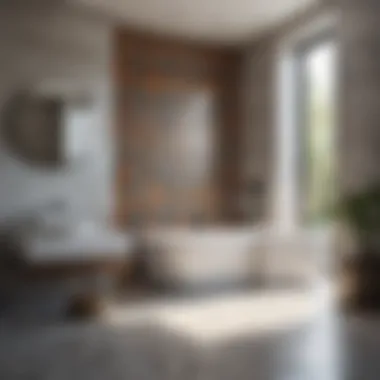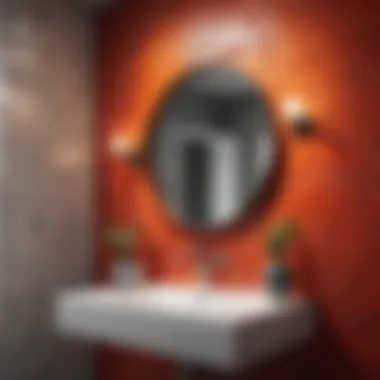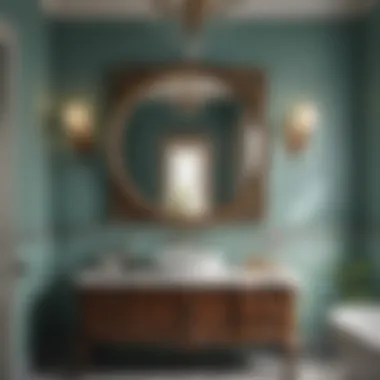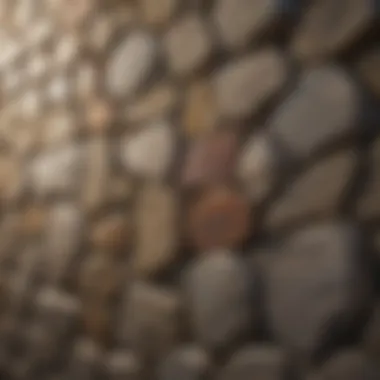Choosing the Best Wall Coverings for Bathrooms


Intro
Selecting the right wall covering for a bathroom is not merely a design choice; it significantly influences both the visual appeal and the practical functionality of the space. Bathrooms, often characterized by humidity and varying temperatures, require materials that can withstand these conditions while maintaining their aesthetic value. This guide provides essential insights into the different wall covering options available, while emphasizing their individual benefits and drawbacks.
In the sections that follow, we will explore trending styles, effective color palettes, and the most suitable materials for various bathroom environments, ensuring homeowners and decorators are well-informed about their choices. From traditional tiles to modern alternatives like vinyl and paint, each material brings something unique to the table, impacting aspects such as durability, maintenance, and overall design.
Trending Styles
Modern Minimalism
The modern minimalist approach has gained popularity in recent years. It emphasizes simplicity and functionality. Clean lines, uncluttered spaces, and neutral colors define this style. A bathroom adorned in a modern minimalist fashion often features matte finishes and seamless designs.
- Materials: Look for large-format tiles, smooth painted walls, or textured vinyl.
- Colors: Stick to whites, grays, and soft earth tones.
These aspects result in a tranquil atmosphere, promoting an essence of calm while being easy to clean and maintain.
Cozy Rustic
The cozy rustic style offers a warm and inviting aesthetic, typically favored in homes that aim for a natural look. This style often blends elements of wood, stone, and earthy palettes. A rustic bathroom can evoke feelings of a serene spa retreat.
- Materials: Consider using reclaimed wood, stone tiles, or faux wood paneling.
- Colors: Embrace warm neutrals paired with rich blues or greens.
This style is not only visually interesting but also adds character to the space.
Color Palettes
Calming Neutrals
Calming neutrals provide a soft backdrop that enhances relaxation. Shades such as beige, taupe, and muted greens enable a serene environment. Using these colors can make a small bathroom appear larger, and they pair well with various accessories and accents.
Bold Accents
In contrast, incorporating bold accents introduces a pop of personality. A vibrant feature wall or colorful cabinets can be striking. Advocating for balance is key; the rest of the room should maintain a more muted tone to prevent overwhelming the senses.
Using color strategically can transform the entire vibe of a bathroom.
"When you choose your color scheme, think of your mood and intention. Each choice can communicate something powerful about your home and your style."
Prolusion to Bathroom Wall Coverings
Choosing wall coverings for a bathroom is not merely an aesthetic decision; it is a fundamental aspect of the space’s functionality and resilience. This area of the home encounters unique challenges, including high humidity levels, frequent water exposure, and the potential for mold growth. Therefore, the selected materials must effectively handle these conditions while contributing to the overall design vision.
The right wall covering can significantly impact both the atmosphere of the room and its long-term maintenance requirements. Homeowners should consider factors such as moisture resistance, ease of cleaning, and durability when making their choices. Furthermore, wall coverings can serve as a foundation for integrating various design styles, from minimalistic and modern to cozy and traditional. The materials a homeowner chooses can dictate the overall vibe of the space.
The Importance of Wall Coverings
Wall coverings play a critical role in the bathroom environment. They protect the walls from water damage and contribute to the overall aesthetic appeal. Utilizing the correct material can mitigate potential issues such as peeling paint or mold growth, which are common in poorly managed bathroom settings.
Additionally, wall coverings can enhance sound insulation, which is essential in urban settings or shared living spaces. Customizing a bathroom's aesthetic through color, finish, and texture allows homeowners to express their personal style while ensuring the space remains functional.
Criteria for Selecting Wall Materials
When selecting wall materials for bathrooms, several key criteria should be kept in mind. These include:
- Moisture Resistance: The material must handle dampness effectively. Waterproof options are ideal for direct exposure areas such as showers.
- Durability: High-traffic bathrooms need coverings that can withstand wear and tear, particularly from cleaning and daily use.
- Ease of Maintenance: Select materials that can be cleaned easily. Some materials may require specialized cleaning products or techniques.
- Aesthetic Compatibility: The chosen wallpaper or tile should align with the overall decor of the home. Consider existing colors and styles.
- Installation Considerations: Understand whether the materials require professional installation or if they can be DIY projects.
In sum, the process of selecting wall coverings for a bathroom is a multifaceted decision that balances beauty and practicality. Understanding key factors allows homeowners to create spaces that are visually appealing while addressing the specific needs of bathroom environments.
Types of Wall Coverings
In any given bathroom, wall coverings play a pivotal role. They determine not only the overall look but also the functionality of the space. The variety of types available allows homeowners to express their aesthetic preferences while also addressing practical needs. As moisture-rich spaces, bathrooms pose unique challenges. Choosing the appropriate material can vastly influence maintenance requirements, durability, and the visual impact of the room. Each type of wall covering has its specific attributes, and understanding these can lead to more informed decisions.
Tile
Tile remains a classic choice in bathroom wall coverings. It has been favored for generations due to its resilient nature and diverse design options.


Advantages of Tile
Tile offers remarkable resilience to moisture, which is crucial in bathroom settings. One of its key characteristics is its impermeability to water, making it less susceptible to mold and damage compared to other materials. This feature contributes to its poplarity as it maintains its appearance over time. Tiles are available in various colors, patterns, and textures, allowing for customization that aligns with personal style.
Another advantage is the ease of cleaning. Most tile surfaces can be wiped down without fear of damaging the material, which is essential in busy bathrooms where hygiene is a top priority.
Disadvantages of Tile
While there are many strengths, there are also disadvantages associated with tile. One significant aspect is the potential for high installation costs. Professional installation is often required, especially with intricate designs, which can lead to soaring expenses.
Furthermore, grouting, crucial for tile installation, can be a downfall. Grout lines can become discolored over time, leading to additional maintenance challenges. The hard surface can also be unforgiving underfoot, which may not appeal to everyone.
Paint
Choosing paint as a wall covering option allows for a versatile and less permanent makeover.
Water-Resistant Paints
Water-resistant paints are specially formulated to withstand the humid and wet conditions typical of bathrooms. This specific attribute highlights their role in preventing peeling and mildew formation, thus enhancing durability. The benefit of such paints is their ease of application, transforming a look without the need for extensive renovations.
In addition, the vast array of colors available means designers can find the perfect shade to suit any vision.
Color Considerations
Color considerations are crucial when selecting paint for a bathroom. Light colors can make a smaller space appear larger, while darker colors can create a cozy atmosphere. This aspect is essential to note, as the right color can crucially influence the mood within the space.
The choice of color also has implications for long-term satisfaction. Bright colors may fade over time, requiring repainting, while neutrals might appeal to various tastes for longer.
Vinyl Wall Coverings
Vinyl wall coverings have gained traction as an alternative choice, particularly for those seeking ease of maintenance.
Durability and Maintenance
One of the primary features of vinyl wall coverings is their durability. They resist tearing and are less prone to damage from impacts compared to other materials. This durability translates into lower maintenance requirements. Cleaning is usually a simple wipe down, easing the burden often associated with caring for bathroom surfaces.
Design Options
Another compelling attribute of vinyl is its diverse design options. Today, homeowners can choose from various styles that mimic the appearance of traditional materials, such as wood or stone. This versatility allows for aesthetic appeal without sacrificing practical benefits. However, some may argue that vinyl does not carry the same prestige as natural materials, which remains a consideration.
Wood Paneling
Although less common, wood paneling can add warmth and character to a bathroom. However, specific considerations should be kept in mind.
Natural Aesthetic
The natural aesthetic of wood paneling is unmatched. It can provide a rustic charm that brings a unique touch to a bathroom. Many homeowners appreciate the inviting look of wood, which can soften the starkness often seen in modern design.
Unfortunately, bathrooms are not the ideal place for untreated wood due to moisture concerns.
Challenges in Moisture Management
The natural challenge with wood is its sensitivity to humidity. Proper treatment and maintenance are essential to prevent warping and mold growth. Sealing and regular upkeep can remedy some issues, but the intensity of care required is a formidable drawback for many.
Wallpaper
Wallpaper trends continue to evolve, offering an exciting dimension for bathroom design.
Trends in Bathroom Wallpaper
Recent trends lean toward bold patterns and textures that can create a statement, even in smaller spaces. Homeowners are choosing wallpapers that add character to their baths while finding options that are peel-and-stick for easier installation.
Certain wallpapers are now engineered to withstand bathroom conditions, making them a feasible option for sustainable designs.
Choosing the Right Type


When choosing wallpaper, homeowners must consider the material's moisture resistance. Vinyl wallpapers are often recommended for bathrooms due to their durability against humidity. Careful selection is crucial to ensure the longevity of the wallpaper in such an environment. An informed choice can prevent peeling and warping, preserving the intended aesthetic.
Factors Influencing Material Choice
Choosing the right material for bathroom wall coverings is a crucial decision. It goes beyond mere aesthetics, affecting functionality and longevity. The factors influencing material choice must be understood to make informed decisions that serve both visual preference and the specific needs of a moist environment.
Moisture Resistance
Moisture resistance is arguably the most significant factor when selecting wall coverings for bathrooms. Bathrooms are subjected to high levels of humidity, steam from showers, and occasional splashes of water. Therefore, materials need to be impervious or at least resistant to moisture to prevent issues such as mold and mildew.
Options like ceramic tiles, vinyl sheets, and specific water-resistant paints can perform well under these conditions. Each of these materials offers some level of moisture protection, although the effectiveness can vary. For example, ceramic tiles are non-porous and offer excellent resistance. On the other hand, certain paints may require additional coatings or treatments for full efficacy.
"Selecting a moisture-resistant material is essential in developing a long-lasting bathroom space."
Durability and Longevity
Durability is also a paramount concern when considering wall coverings. A bathroom wall surface should withstand daily wear and tear, cleaning processes, and environmental factors intrinsic to bathrooms. The cost implications of replacing wall coverings due to poor durability can be striking.
Tile, for instance, is known for its durability. It can endure impacts and is less susceptible to scratches. Vinyl is another option that presents high resilience, but it may show wear over time more than harder materials. In contrast, wallpaper, while offering aesthetic appeal, usually lacks longevity unless specifically marketed for high-humidity areas, hence requiring more frequent replacement. Assessing how a material’s durability aligns with your lifestyle is essential for making a choice that will last.
Aesthetic Preference
Aesthetic preference plays an important role in the decision-making process for wall coverings as well. The visual appeal contributes significantly to the overall atmosphere of a bathroom. A space can feel relaxing, modern, or even luxurious, depending on the choice of covering.
When considering aesthetic preferences, one needs to think about color, pattern, and texture. Bright colors can make a space feel larger and more energetic, while darker tones may impart a sense of coziness. Wallpaper can introduce intricate patterns and textures that may be difficult to replicate with other materials. However, the aesthetic should not override practical considerations such as moisture resistance and durability. Here, a balance must be struck between beauty and function to ensure a satisfying final result.
Current Trends in Bathroom Wall Coverings
The selection of wall coverings for bathrooms is not stagnant; it evolves with time and influences from design trends, technology, and consumer preferences. Knowing what trends dominate in today’s market can help homeowners make informed choices that reflect both functionality and personal style. This section examines three significant trends: bold colors and patterns, textured finishes, and sustainable materials. Each trend offers unique advantages and considerations that can greatly enhance bathroom aesthetics and usability.
Bold Colors and Patterns
The use of bold colors and striking patterns in bathroom wall coverings has gained momentum in recent years. Unlike traditional neutral palettes, current trends embrace vivid, expressive color schemes. These choices allow homeowners to create a strong visual impact in usually smaller spaces.
Benefits of Choosing Bold Colors and Patterns:
- Dramatic Appeal: Bright colors can energize a room or create a cozy atmosphere, depending on the shades chosen.
- Pattern Play: Incorporating geometric or floral patterns adds depth and personality to bathroom walls.
- Mood Enhancement: Certain colors, such as turquoise or soft yellows, can evoke feelings of tranquility or warmth.
However, balancing these bold options with complementary elements is crucial to avoid overwhelming the space. Accessories, fixtures, or even flooring can help create harmony with vibrant wall choices.
Textured Finishes
Textured finishes are being increasingly preferred in bathroom wall coverings, providing layers of tactile experience. These finishes, including shiplap, plaster, or wallpaper with a tactile pattern, serve both aesthetic and practical purposes.
Key Considerations for Textured Finishes:
- Visual Interest: Textures can bring a sophisticated, layered look that draws the eye, making the bathroom more inviting.
- Practicality: Many textured materials can help hide water spots and imperfections that may occur in high-moisture areas.
While textured options can add character to bathroom walls, they may also require more maintenance to keep surfaces clean and looking fresh. Proper choices of materials that can withstand humidity are essential.
Sustainable Materials
More homeowners are prioritizing sustainability in their choices for wall coverings, promoting a responsible approach to design. Sustainable materials offer an eco-friendly alternative that contributes to a healthier environment. This shift reflects wider consumer awareness surrounding ecological impacts.
Advantages of Using Sustainable Materials:
- Lower Environmental Impact: Products made from recycled materials, bamboo, or reclaimed wood can reduce the consumption of new resources and waste.
- Healthier Choices: Many sustainable materials lack harmful chemicals often found in conventional products, thus contributing to better indoor air quality.
As the trend of sustainability rapidly grows, the market sees more innovations and options that blend environmental responsibility with style. Homeowners willing to invest in sustainable materials may find beautiful solutions that align with their ethical values.
"The choice of wall covering can influence not only the aesthetic appeal of a bathroom but also its environmental footprint."
In summary, current trends in bathroom wall coverings underscore a shift towards personalization and environmental consciousness. Bold colors and patterns provide a canvas for individual expression, textured finishes enhance sensory experiences, and sustainable materials address pressing ecological concerns. Embracing these trends can help homeowners create beautiful and functional bathrooms that truly reflect their values and tastes.
Installation Considerations


Choosing the right wall covering for a bathroom goes beyond aesthetics. It also involves understanding how these materials interact with installation processes. The installation choice will determine the longevity and functionality of the wall covering, making it a critical consideration during planning. Not only can proper installation enhance the appearance of the space, but it can also affect moisture resistance and ease of maintenance.
When selecting wall coverings, consideration must be given to whether to hire professionals or take the DIY approach. Each option carries its own advantages and potential drawbacks, which need to be balanced against personal capabilities and project expectations.
Professional vs. DIY Installation
Deciding between professional installation and a do-it-yourself (DIY) approach largely depends on skill level, time availability, and budget constraints. Using professionals can ensure that work is done correctly and can save time. They are trained to handle complexities in various materials, such as tile and wallpaper, which may require specialized tools or techniques.
On the other hand, DIY installations can be a rewarding challenge for some homeowners. If one has a knack for renovation projects, this can result in significant cost savings. Basic wall coverings, like vinyl or certain paint types, might be manageable for DIY enthusiasts. However, improper installation can lead to issues like peeling, mold growth, and even structural problems.
Consider these points when choosing:
- Skill level: Assess your own experience before committing.
- Time available: Professional help may expedite the project if time is short.
- Complexity: Some materials are trickier to install than others.
Cost Implications
Budget concerns play a significant role in all home renovation projects, including wall coverings. Professional installation rates vary based on the type of material, geographical location, and labor intensity.
For instance, tiling is often more expensive due to the labor-intensive nature of the work involved. If the project requires special equipment or extensive preparation, such as wall leveling or extensive pattern matching, costs can escalate quickly.
On the other hand, opting for DIY installations usually reduces the overall expense. However, it is essential to factor in potential costs related to mistakes made during installation. Problems such as misalignments or inadequate sealing can lead to additional repairs, creating hidden costs.
When considering your budget, take note of these aspects:
- Cost of materials: Research prices for both materials and installation methods.
- Labor costs: If hiring professionals, get quotes from several contractors.
- Potential savings: Calculate how much you save with DIY versus the potential costs of mistakes.
In summation, careful consideration of installation methods and associated costs is vital. Balancing these factors will help ensure your bathroom wall covering meets both aesthetic and functional requirements.
Maintenance and Care
Maintaining the wall coverings in your bathroom is crucial for both longevity and aesthetics. Proper care goes beyond dusting; it involves specific techniques based on the material used. This section not only highlights the importance of maintenance but also provides practical insights into the best cleaning practices and protective measures. A well-maintained bathroom not only looks appealing but also contributes to a healthier living environment by preventing mold and mildew growth.
Cleaning Techniques for Different Materials
Each material used for bathroom walls requires distinct cleaning methods. Knowing these can prevent damage and preserve the visual appeal of the surface. Here are some common materials and their recommended cleaning techniques:
- Tile: For ceramic and porcelain tiles, a mixture of warm water with a mild detergent works well. Avoid using abrasive scrubs, as they can scratch the surface. For grouts, consider a paste made from baking soda and water. Apply it, let it sit for a few minutes, then scrub gently with a toothbrush.
- Paint: Use a soft cloth or sponge and a mixture of water and gentle soap. For stains, a diluted vinegar solution can be effective. Always test in a small area first to ensure the paint does not discolor.
- Vinyl Wall Coverings: These are generally low maintenance. A damp cloth with a little soap is typically sufficient. For tougher stains, a non-abrasive cleaner can be applied.
- Wood Paneling: This material requires special care. Use a dry cloth to dust. If necessary, a slightly damp cloth can be used, but be careful not to soak the wood. After cleaning, applying a wood conditioner can help maintain its appearance.
- Wallpaper: Vinyl or coated wallpapers can be wiped clean with damp cloths. Be sure to check the manufacturer’s instructions. Ensure that any cleaning does not involve excessive moisture, which could affect the adhesive.
Protective Coatings and Treatments
To prolong the lifespan of the bathroom walls, applying protective coatings can be beneficial. These treatments not only enhance the look but also prevent moisture damage and staining. Consider the following:
- Sealants for Tile and Grout: Applying a penetrating sealant can create a barrier against moisture and stains. This is particularly important in areas with substantial water exposure.
- Paint Sealers: For painted walls, specialized sealers or finishes can protect against water damage and make cleaning easier. Options include satin or semi-gloss finishes, which are highly recommended for bathrooms.
- Water-Resistant Coatings for Wood: Wood in bathrooms is susceptible to moisture, so it's wise to apply water-resistant coatings. These products can minimize warping and mold growth.
"Routine maintenance not only preserves the beauty of your bathroom but also ensures a healthier and safer living space."
Understanding the specific requirements for each material can enhance their performance. The balance between aesthetic appeal and practical care will keep your bathroom looking fresh and inviting.
Final Recommendations
The section on final recommendations serves as a crucial conclusion in the exploration of bathroom wall coverings. Understanding the appropriate selections can bridge the gap between aesthetic appeal and functional excellence. It is imperative that homeowners and decorators consider their unique circumstances when making decisions about wall materials. Various factors influence these choices, including moisture levels, styling preferences, and budget.
Assessing Your Unique Bathroom Needs
When evaluating which wall covering to choose, it is essential to first assess the specific needs of your bathroom. Different bathrooms serve different purposes, from luxurious master suites to functional family spaces. Consider the following elements:
- Moisture Levels: Bathrooms are inherently wet areas; therefore, materials need to withstand high humidity. For instance, tiles offer excellent water resistance compared to wallpaper.
- Space Size: Smaller bathrooms may appear more expansive with lighter colored or glossy finishes, while larger spaces can accommodate darker hues or textured looks without overwhelming the room.
- Traffic: More frequently used bathrooms should prioritize durability. Vinyl may be better suited for high-traffic areas due to its ease of maintenance in comparison to wood paneling.
- Style and Aesthetic: Determine whether your preference leans toward contemporary or classic styles. This choice can heavily influence the materials that align with your vision.
By carefully analyzing these factors, you can create a personalized approach that effectively meets the demands of your particular bathroom environment. This will not only enhance visual appeal but also ensure long-term satisfaction with your wall covering choice.
Future Trends to Watch
As trends in bathroom design continue to evolve, it is vital to stay informed about materials and styles that are gaining popularity. Some notable trends include:
- Eco-Friendly Materials: Sustainable choices are increasingly preferred. Brands are producing wall coverings made from recycled or renewable resources. This move not only benefits the environment but also promotes a healthier living space.
- Smart Technologies: Incorporating technology in bathroom designs is on the rise. Emerging products include moisture-resistant materials equipped with smart features that can regulate temperature and humidity.
- Bold Color Palettes: Recent trends reflect a shift toward bolder colors. Homeowners are now more open to using striking shades to create focal points or accent walls, standing in contrast to the previous neutrals.
- Digital Printing: Advances in digital printing technology are permitting unique designs, making wallpaper a versatile option again. Customers can select custom prints that suit their needs perfectly.
Keeping an eye on these trends may lead to innovative solutions and aesthetics that complement the overall bathroom design while ensuring modern functionality. The ability to adapt to evolving styles will allow for continuous enhancement of your space.
Remember that choosing the right materials for your bathroom is not merely a design decision; it affects your daily life in terms of comfort, maintenance, and overall satisfaction.
By focusing on unique needs and keeping future trends in mind, you can make informed decisions that will stand the test of time.















